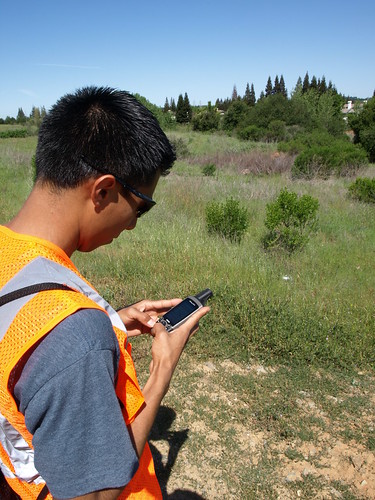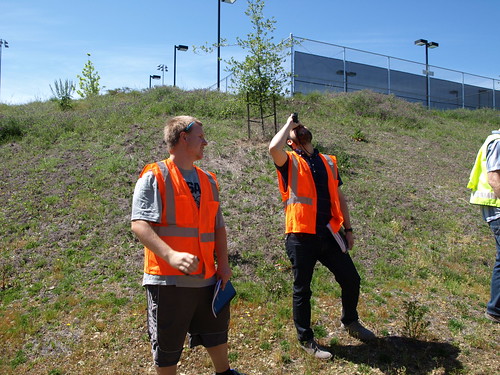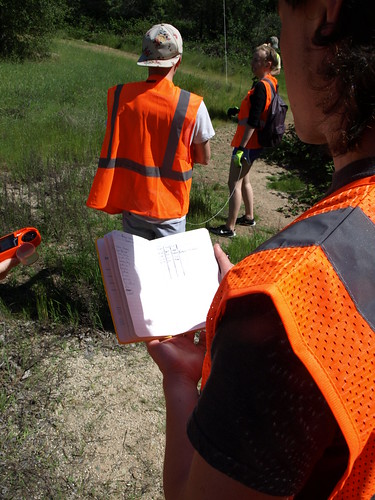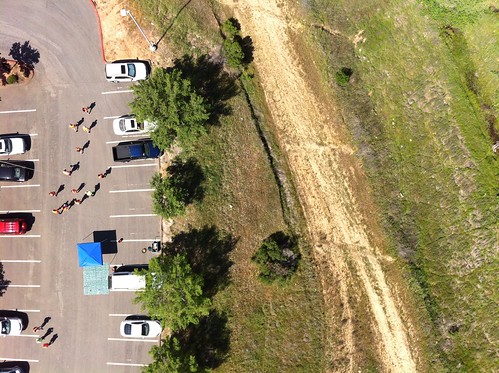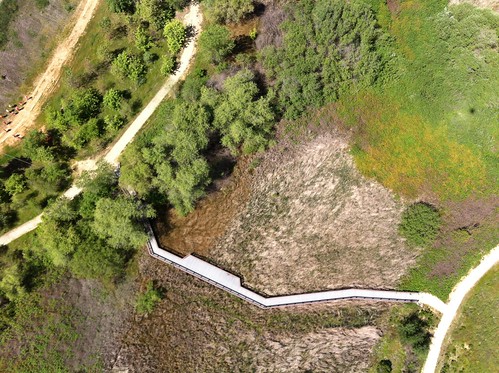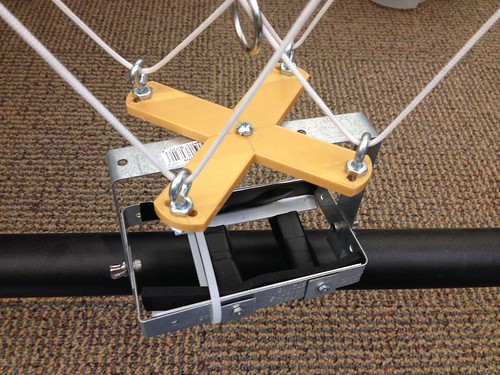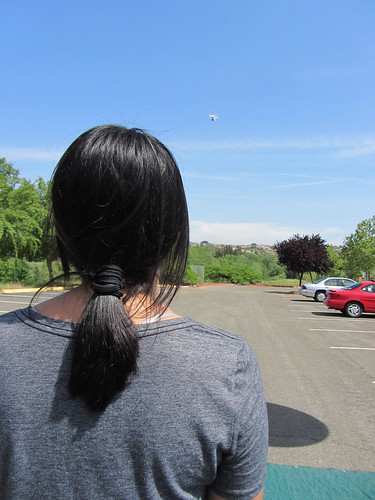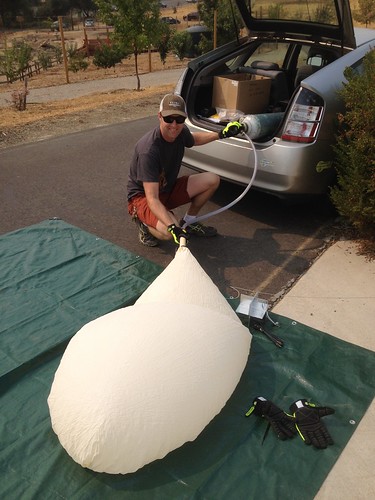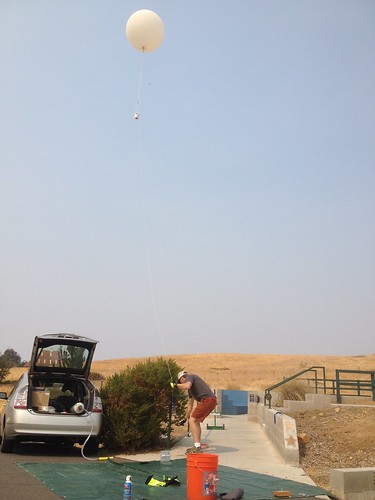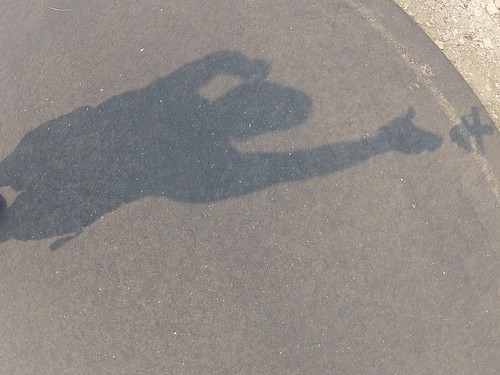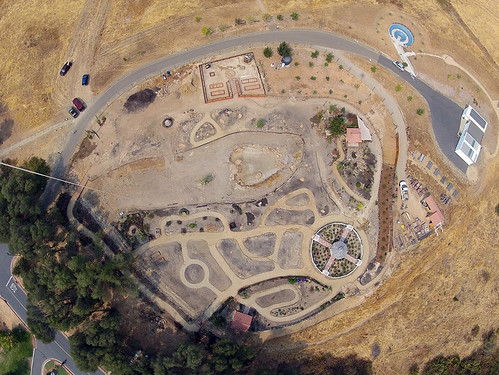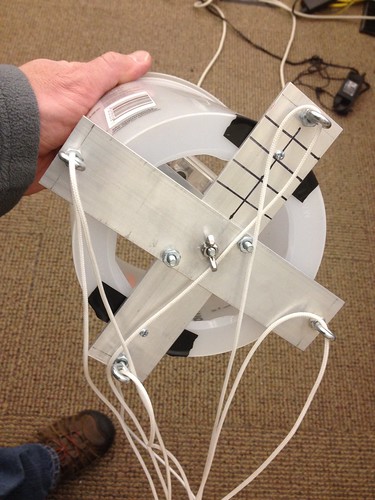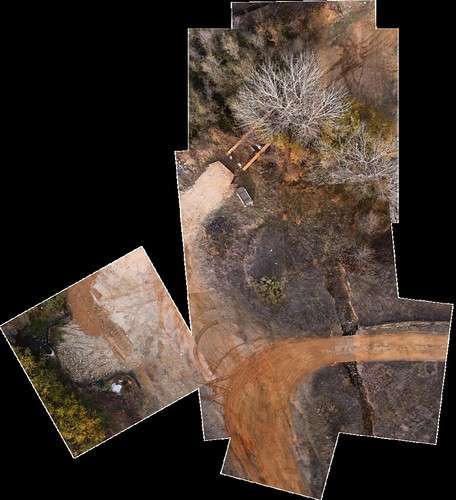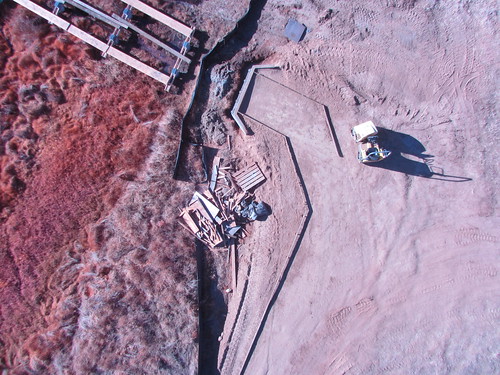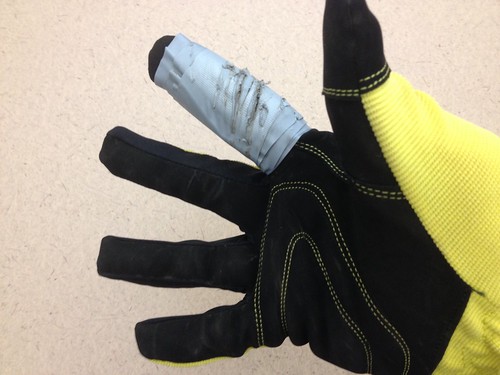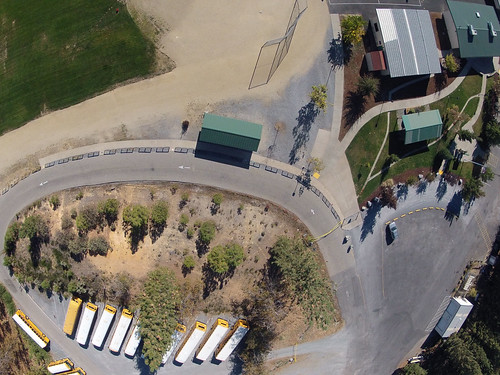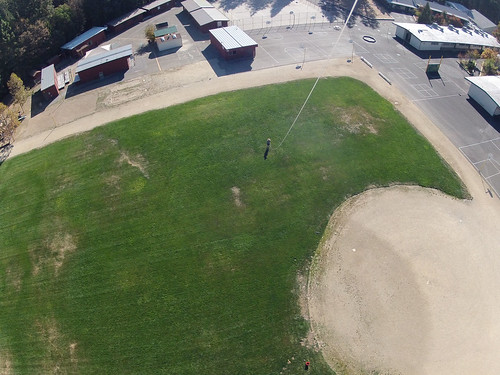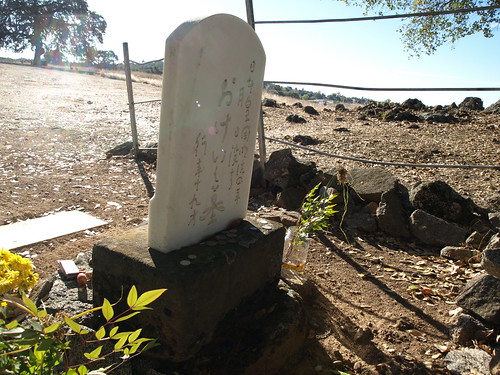Whenever we do a flight day, we try and have at least one student taking photos and documenting the process. Here are some Folsom Lake College students at our most recent BAP field day doing science – taking GPS coordinates, shooting the balloon with the laser rangefinder, and logging data.
Field day with Jason Pittman’s (Geosciences) class yesterday. The balloon pulled well, I think thanks in part to the weight reductions we achieved with the new 3D printed picavet part.
Full dataset here: https://drive.google.com/folderview?id=0B1HizVK87qvsS3kxX3A4OGM4WFU&usp=sharing
Did a quick SketchUp model of a picavet and printed it for a BAP day on Wednesday. Much lighter than the setup it replaced.
When I have a little more time, I’ll look into replacing all the metal parts with printed plastic ones.
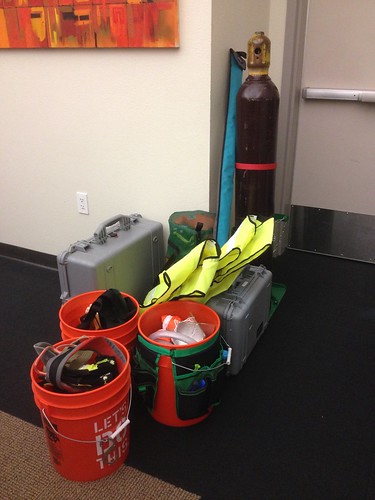
Kite? Check. Helium? Check. It takes quite a bit of gear to execute a proper field day. Professor Jason Pittman arranged a KAP/BAP field day, and we headed up to the wetlands on the north end of campus to meet students around noon. Following a brief safety talk and protocol orientation, one team set out to launch the balloon, while the other team assembled and attempted to launch the kite.
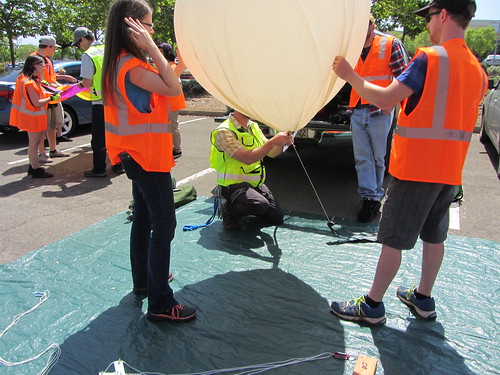
Half-full, balloon #1 revealed some pinhole leaks, so we tried to move the gas to a second balloon, which didn’t work at all, and we popped the first one in the process. Fortunately, we were able to get one of the spares filled and in the air.
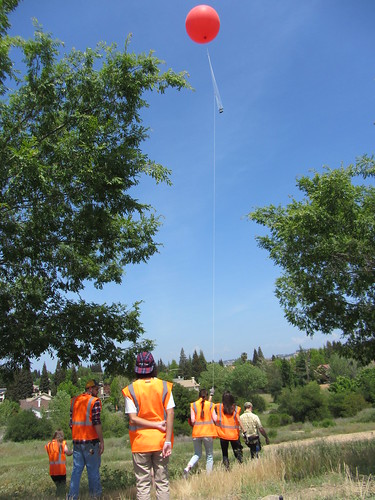
The kite team struggled with inconsistent wind. After many heroic attempts, they eventually scrapped the launch and joined the balloon team to walk the wetlands.
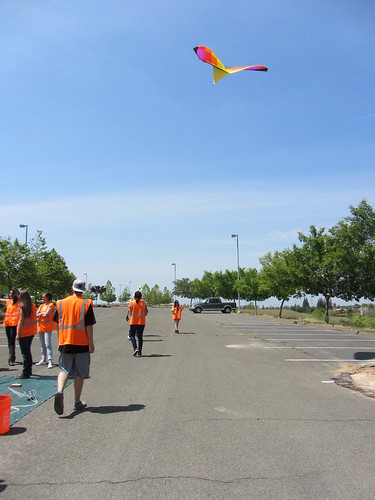
We flew for ~40 minutes, with the camera (iPhone on the picavet, running Timelapse at 10 second intervals), and captured some really good shots. (Link: The full set images from 04.24.15 BAP field day.)
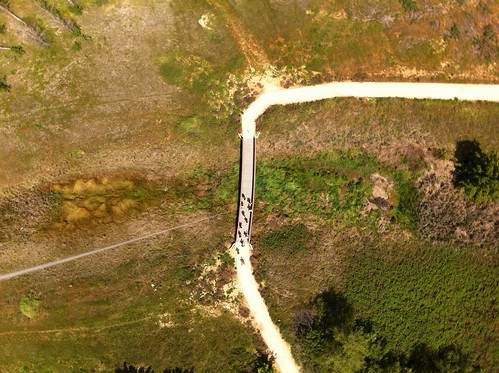
At 2 o’clock, we headed back to the cars to stow the gear and head out. A few students hung around and had a chance to fly our newest quad.
With the easing of the helium shortage, we finally acquired a tank or two of the noble gas, and headed up to the El Dorado Center yesterday to launch our new imaging platform. First flights are always a little nerve-wracking, with safety considerations and weather variables and unknowns, but we drafted a protocol, filled the balloon, and sent it up.
We had used half the tank the other day on an aborted attempt – the balloon popped – so we ran out of gas a little short of the balloon’s capacity. While it lifted the picavet, it wasn’t especially enthusiastic about it. We brought it back to the ground, changed the 300# line to 100#, removed the bucket, and sent it back up. These weight tweaks worked well, and the balloon pulled the load gently but definitively.
A balloon is quite a different animal than a kite, and flying it took some getting used to. All in all, quite a bit less stressful than kites or quadcopters, as the helium counteracts (most of) the drop-out-of-the-sky, camera crushing effects of gravity. We were able to capture this nice image of the El Dorado County Master Gardeners Demonstration Garden, a work in progress, and one that we can hopefully document over time with additional flights.
Overall, a satisfying success. Next steps include constructing a new, lighter picavet specifically for the balloon, and finalizing the POV streaming rig we plan to fly over the crowd at a college event in October.
It’s been pretty quiet on the flying front this winter, but we’ve got a field day planned for Cronan Ranch tomorrow, so I took a few minute to mod the picavet. In the prior incarnation, the bucket was not attached to the picavet cross, but was instead sandwiched between the cross and the camera mount. As such, every time the camera mount had to be changed, the bucket came with it, making for some annoying alignment issues.
To remedy, I cut away the middle of the top of the bucket (to make camera attachment a little easier, and to make the camera screen visible from outside of the bucket – the camera is always pointed straight down, and without access to the screen it’s sometimes difficult to tell if the camera is firing ), and attached the bucket directly to the picavet cross via two machine screws. Much better. Let’s hope the predicted winds arrive tomorrow…
The weather was pretty good for KAP yesterday, with variable ground level winds somewhere in the 2-5 mph range, so we took the 9′ delta down to the wetlands north of the college to test out the new iPhone rig. Gathered two hundred or so shots using Timelapse, a very useful app, and worth every penny of the $4.99 asking price. Unfortunately, I misaligned the iPhone within the protective bucket, such that each image contained a bit of the edge of said bucket. As a result, I had to run a Photoshop action to crop the images, losing a bit of data in the process. Nevertheless, I was able to stitch together some of the best photos using both Photoshop and MapKnitter, which I’ve mentioned before:
MapKnitter is a free and open source tool for combining and positioning images in geographic space into a composite image map. Known as “orthorectification” or “georectification” to geographers, this step covers the process of figuring out where images can be placed on an existing map, and how they can be combined, or “stitched” together.
With each successful (and unsuccessful) flying session, we’re learning a great deal. For instance, we’ve added a can of compressed air to the field kit to deal with the inevitable dust that seems to find its way onto the camera, and before the next flight, I’m going to find some sort of ground cloth to use as a relatively clean surface upon which to set up the picavet and rig the camera. Progress.
Flew the 9′ delta this afternoon in the wetlands below the college, and sent the NIR camera up for the first time, resulting in photos that look something like this:
1. Flying solo is more difficult than flying with a partner. I had to find a stable elevation for the kite, step on the line, and rig the picavet with one hand. A few times when the camera was dangerously close to the ground, it would have been nice to have a partner to keep it safe from harm.
2. Given the way that that camera sits inside the bucket, it’s a little difficult to operate it. I’m going to noodle on a solution…
3. Always bring a broad-brimmed hat and/or sunglasses. I had neither.
4. Always always wear gloves. I burned through about eight wraps of duct tape in this one flying session. I like the overall weight of the glove pictured below, I just need to find a way to add a heavy duty sleeve to that finger.
5. A 1 minute interval is too long. I’m thinking that 30 seconds will give more overlap, which will enable better knitting.
The weather is changing today, bringing cooler temperatures and, most importantly, steady wind. I took the KAP rig down to the local grade school, and after some fussing, was able to get it up in the air. At about 100′ feet the kite found a steady wind, so I attached the picavet to the line and sent it up. The kite kept pulling like a champ, so I kept feeding it line until the line ran out.
After a few more practice runs, we’ll send the IR camera up, hopefully at Wakamatsu or over the wetlands below the college.
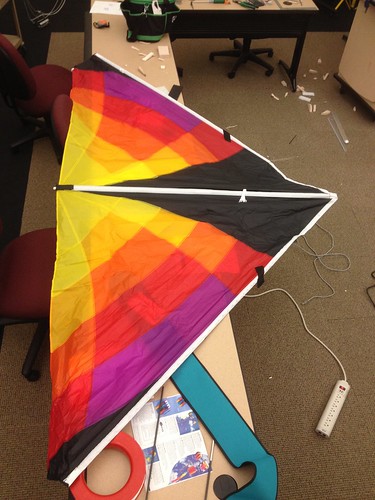
Spent the day Friday touring Wakamatsu Tea and Silk Colony Farm, an historic area above the American River in Gold Hill with one of co-conspirator Jason Pittman’s California Geography classes. Visited the grave of Okei, the first recorded burial of a Japanese woman in the United States.
Jason and his students have done some work for the American River Conservancy in the past, GPSing trails and the like, and we’re working on a plan to do some aerial imaging in support of ARC’s Wakamatsu re-vegetation and de-vegetation efforts – yellow star thistle is a mean invasive weed, and it is everywhere on the Wakamatsu property (and throughout the county). Following the tour, we assembled and practiced flying the delta. The anemometer was registering inconsistent winds at ground level in the 2-4 mph range, which was enough to get the kite up in the air a few times, but not enough to keep it there, nor to allow it to really lift the camera rig.
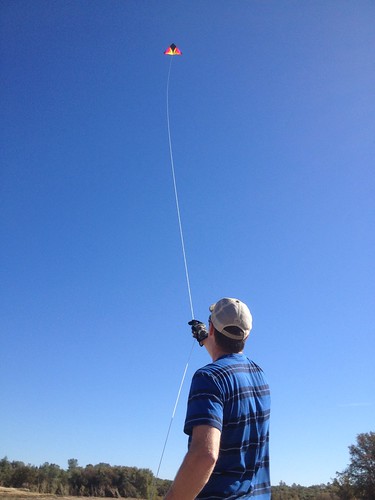
Though we weren’t able to gather any images, we did learn a lot about flying the kite, rigging the picavet, and what to include in our KAP kit. All in all a successful day. Always be prototyping!

